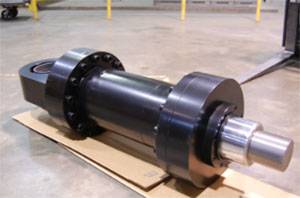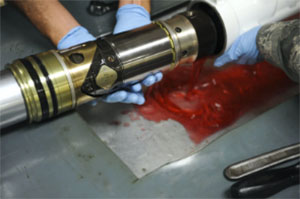Hydraulic cylinders are an important part of many different types of machinery in many industries. When a hydraulic cylinder fails, the results can range from annoying to dangerous. It is important to understand the nature of the hydraulic cylinder failure, including the cause of the failure and how to best solve it once the failure occurs. This paper brings the common faults and solutions of hydraulic cylinder.
1. hydraulic cylinder:

hydraulic cylinder lateral load
A hydraulic cylinder (you can call it a linear hydraulic motor) is a hydraulic actuator used to achieve linear motion by effectively transmitting force with a virtually incompressible hydraulic fluid. They can be found in almost every industry, from large earth-moving machinery such as hydraulic excavators to the aviation industry, where they can be found on aircraft and ground support equipment. Hydraulic cylinders are usually a key component of any system in which they are found, which means that the failure of the hydraulic cylinder may cause problematic downtime. Therefore, it is important to understand the causes of hydraulic cylinder failure and what measures can be taken to prevent these failures.
2. the components in the hydraulic cylinder:
The most important components in a hydraulic cylinder include: the barrel (which encates most of the parts), the piston rod (this is the part most people see), the piston (the piston that transmits motion to the piston rod), the cylinder head, the cylinder head, and various seals and bearings. Failure of any one of these components affects the entire hydraulic cylinder.
3. chemical attack:
Hydraulic cylinders are typically used in environments that may come into contact with corrosive materials. When such an environment is present, the cylinder seal is usually affected first (depending on which material the cylinder seal is made of). If signs of chemical attack are found on the seal, not only the seal needs to be replaced, but also the seal needs to be replaced with a sealing material compatible with the corrosive chemicals in the working environment. If purchasing a new hydraulic cylinder system, it is wise to contact the manufacturer about potential chemical problems with the seal.
4. contaminated hydraulic oil:
Contaminated hydraulic oil can appear in two problematic forms in hydraulic cylinders: air or water pollution and particle pollution. The presence of air or water in the hydraulic fluid will affect the performance of the hydraulic cylinder, thereby affecting the load and the power of the stroke that the hydraulic cylinder can withstand. On the other hand, particulate contamination can break the seal and cause other serious problems. Most particle contaminants appear in the form of abrasive particles. Once these particles find themselves trapped between the surface of the piston rod and the piston rod seal, the seal will be damaged and start to leak. Most contaminants are introduced into the hydraulic seal through a faulty wiper gasket, but if the cleaning procedure is not followed, the hydraulic seal may also be introduced during maintenance and repair.
5. barrel internal corrosion:
If water is allowed to enter the inside of the hydraulic cylinder, it may cause corrosion inside the cylinder barrel. This type of damage is difficult to repair and often involves replacing the affected parts. The best way to prevent such damage is to prevent water ingress, which usually occurs due to seal damage. On the other hand, such damage may also indicate that the cylinder is not suitable for the type of environment in which it is used.
6. eye bearing damage:
The eyeball bearing will fail under one of two conditions:(1) when the cylinder is subjected to a load exceeding its specification; or (2) when the cylinder is subjected to a sudden shock or shock load. If the load exceeds the specified load of the cylinder, a failure will occur, and it is usually an eyeball.
7. piston rod bearing and piston rod damage:

The cause of piston rod bearing damage and piston rod bending is usually the incorrect alignment between the cylinder and the load, but it may also be caused by the load of the hydraulic cylinder exceeding the specified load. If the alignment is incorrect, side loads or bending will occur, which means that the rod bearing cannot carry.
8. concave rod and barrel:
The barrel or rod of the hydraulic cylinder may be recessed deep enough to cause performance problems and require its replacement. This damage is usually caused by a collision with another piece of equipment or a very heavy object. It is usually displayed when the rod cannot be fully extended or retracted (that is, the cylinder cannot be fully traveled). Trying to continue to use a cylinder with a recessed rod or barrel will damage other components, including bearings and seals.
Excessive 9. wear:
Most cases of excessive wear can be traced to misalignment of the rod and cylinder. When these two components are not correctly aligned, an additional force perpendicular to the movement of the rod will be generated, called a thrust load or side load. These forces eventually lead to damage to bearings, pistons, rods and barrels.
10. temperature extremes:

Another major cause of hydraulic cylinder failure is extreme operating temperatures-too cold and too hot. When the operating temperature is too high, it may cause premature failure of the seal. In addition, at high temperatures, the ability of the fluid to adequately lubricate key parts can also become a problem and cause premature wear and significantly reduce efficiency. This can usually be seen when the bearing fails too early. Excessive temperatures can also accelerate the natural degradation of hydraulic fluids and lubricants.
On the other hand, if the operating temperature is too low, the lubricant and hydraulic oil will become too thick to work properly and may damage the hydraulic cylinder. Low temperatures can also cause the sealing material to become brittle, causing the sides to crack. If the seal is affected by extreme temperatures, the affected seal should be replaced with a seal made of a material compatible with the operating temperature.
If the hydraulic oil and lubricant are adversely affected by the operating temperature, another type rated for the expected operating temperature should be used.
XI. Extrusion Seal:
Another major problem that can occur with hydraulic cylinders is seal squeezing, which usually occurs between the barrel and the cylinder head or cylinder head. When the lip of the seal begins to protrude into the extrusion gap, it will experience extreme wear. Fragments of the sealing lip may be torn off, introducing contaminants into the system and causing the seal to leak. When there is evidence that the seal has begun to extend into the extrusion gap, other types of seal materials or seal geometries are required.
12. Leakage seal:

The most common cause of hydraulic cylinder failure is seal leakage, which not only allows critical fluids (including lubricants) to leave the system, but also allows harmful contaminants (water, air, and particles) to enter the hydraulic cylinder. Most of the causes of seal failure are the use of the wrong size seal, improper clearance between the seal and the surface, erosion of the seal, excessive wear due to abrasive fluid contamination, poor alignment between the piston rod seal and piston rod, and improper installation. However, please remember that the seals will inevitably wear out over time and reach the point where they must be replaced.
Conclusion:
Most hydraulic cylinder failures are caused by problems related to seals (including leakage, contamination, and extrusion), bearings (including rod bearings and eye bearings), and dents in the rod or barrel. The most common causes of hydraulic cylinder failure are misalignment, extreme temperatures, normal or excessive wear, chemical corrosion, corrosion and hydraulic contamination. The secret to preventing most of these failures is very simple: regular preventive maintenance. For example, fluid testing may reveal many problems (e. g., air or water contamination, particulate contamination, corrosion, chemical attack, and temperature reduction). Visual inspection can reveal misalignment, seal leaks, corrosion, and dented rods and barrels.










